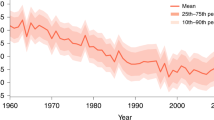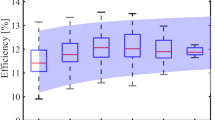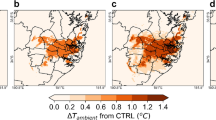Abstract
Air pollution and dust prevail over many regions that have rapid growth of solar photovoltaic (PV) electricity generation, potentially reducing PV generation. Here we combine solar PV performance modelling with long-term satellite-observation-constrained surface irradiance, aerosol deposition and precipitation rates to provide a global picture of the impact of particulate matter (PM) on PV generation. We consider attenuation caused by both atmospheric PM and PM deposition on panels (soiling) in calculating the overall effect of PM on PV generation, and include precipitation removal of soiling and the benefits of panel cleaning. Our results reveal that, with no cleaning and precipitation-only removal, PV generation in heavily polluted and desert regions is reduced by more than 50% by PM, with soiling accounting for more than two-thirds of the total reduction. Our findings highlight the benefit of cleaning panels in heavily polluted regions with low precipitation and the potential to increase PV generation through air-quality improvements.
This is a preview of subscription content, access via your institution
Access options
Access Nature and 54 other Nature Portfolio journals
Get Nature+, our best-value online-access subscription
$29.99 / 30 days
cancel any time
Subscribe to this journal
Receive 12 digital issues and online access to articles
$119.00 per year
only $9.92 per issue
Buy this article
- Purchase on Springer Link
- Instant access to full article PDF
Prices may be subject to local taxes which are calculated during checkout





Similar content being viewed by others
Data availability
The datasets generated and analysed during the current study are available from the corresponding authors on reasonable request.
Code availability
The custom code generated during the current study is available from the corresponding authors on reasonable request.
References
Renewables 2019 Global Status Report (REN 21, 2019).
PVPS 2019 Snapshot of Global PV Markets (International Energy Agency, 2019).
Feldman, D. & Margolis, R. Q4 2018/Q1 2019 Solar Industry Update (National Renewable Energy Laboratory, 2019).
Technology Roadmap—Solar Photovoltaic Energy (International Energy Agency, 2014).
Aerosol Optical Thickness (1 month—Terra/MODIS) (NASA, 2017).
Streets, D. G. et al. Anthropogenic and natural contributions to regional trends in aerosol optical depth, 1980–2006. J. Geophys. Res. 114, D00D18 (2009).
Babu, S. S. et al. Trends in aerosol optical depth over Indian region: potential causes and impact indicators. J. Geophys. Res. Atmos. 118, 11794–11806 (2013).
Ridley, D. A., Heald, C. L., Kok, J. F. & Zhao, C. An observationally constrained estimate of global dust aerosol optical depth. Atmos. Chem. Phys. 16, 15097–15117 (2016).
Li, X., Wagner, F., Peng, W., Yang, J. & Mauzerall, D. L. Reduction of solar photovoltaic resources due to air pollution in China.Proc. Natl Acad. Sci. USA 114, 11867–11872 (2017).
Labordena, M., Neubauer, D., Folini, D., Patt, A. & Lilliestam, J. Blue skies over China: the effect of pollution-control on solar power generation and revenues. PLoS ONE 13, e0207028 (2018).
Sweerts, B. et al. Estimation of losses in solar energy production from air pollution in China since 1960 using surface radiation data. Nat. Energy 4, 657–663 (2019).
Sarver, T., Al-Qaraghuli, A. & Kazmerski, L. L. A comprehensive review of the impact of dust on the use of solar energy: history, investigations, results, literature, and mitigation approaches. Renew. Sustain. Energy Rev. 22, 698–733 (2013).
Costa, S. C. S., Diniz, A. S. A. C. & Kazmerski, L. L. Dust and soiling issues and impacts relating to solar energy systems: literature review update for 2012–2015. Renew. Sustain. Energy Rev. 63, 33–61 (2016).
Boyle, L., Flinchpaugh, H. & Hannigan, M. Assessment of PM dry deposition on solar energy harvesting systems: measurement–model comparison. Aerosol Sci. Technol. 50, 380–391 (2016).
Singh Rajput, D. & Sudhakar, K. Effect of dust on the performance of solar PV panel. Int. J. ChemTech Res. 514, 974–4290 (2013).
Adinoyi, M. J. & Said, S. A. M. Effect of dust accumulation on the power outputs of solar photovoltaic modules. Renew. Energy 60, 633–636 (2013).
Al-Ammri, A. S., Ghazi, A. & Mustafa, F. Dust effects on the performance of PV street light in Baghdad City. In 2013 International Renewable and Sustainable Energy Conference (IRSEC) 18–22 (IEEE, 2013).
Bergin, M. H., Ghoroi, C., Dixit, D., Schauer, J. J. & Shindell, D. T. Large reductions in solar energy production due to dust and particulate air pollution. Environ. Sci. Technol. Lett. 4, 339–344 (2017).
Gueymard, C. A., Habte, A. & Sengupta, M. Reducing uncertainties in large-scale solar resource data: the impact of aerosols. IEEE J. Photovolt. 8, 1732–1737 (2018).
Suri, M. & Cebecauer, T. Satellite-based solar resource data: model validation statistics versus user’s uncertainty. In ASES SOLAR 2014 Conference (ASES, 2014).
Parrott, B., Carrasco Zanini, P., Shehri, A., Kotsovos, K. & Gereige, I. Automated, robotic dry-cleaning of solar panels in Thuwal, Saudi Arabia using a silicone rubber brush. Sol. Energy 171, 526–533 (2018).
Andrews, R. W., Stein, J. S., Hansen, C. & Riley, D. Introduction to the open source PV LIB for Python photovoltaic system modelling package. In IEEE 40th Photovoltaic Specialist Conference (PVSC) 170–174 (IEEE, 2014).
Stein, J. S., Holmgren, W. F., Forbess, J. & Hansen, C. W. PVLIB: open source photovoltaic performance modeling functions for Matlab and Python. In IEEE 43rd Photovoltaic Specialists Conference 3–8 (IEEE, 2016).
Holmgren, W. F., Andrews, R. W., Lorenzo, A. T. & Stein, J. S. PVLIB Python 2015. In IEEE 42nd Photovoltaic Specialist Conference (PVSC) 1–5 (IEEE, 2015).
CERES SYN1deg Ed3A (CERES Science Team, 2016).
Doelling, D. R. et al. Geostationary enhanced temporal interpolation for CERES flux products. J. Atmos. Ocean. Technol. 30, 1072–1090 (2013).
Rutan, D. A. et al. CERES synoptic product: methodology and validation of surface radiant flux. J. Atmos. Ocean. Technol. 32, 1121–1143 (2015).
Kaye, J. et al. Use of Satellite Observations in NASA Reanalyses: MERRA-2 and Future Plans (Coordination Group for Meteorological Satellites, 2015).
Bosilovich, M. G. et al. MERRA-2: Initial Evaluation of the Climate (Technical Report Series on Global Modeling and Data Assimilation, Vol. 43, NASA, 2015).
Molod, A., Takacs, L., Suarez, M. & Bacmeister, J. Development of the GEOS-5 atmospheric general circulation model: evolution from MERRA to MERRA2. Geosci. Model Dev. 8, 1339–1356 (2015).
Reichle, R. H. et al. Land surface precipitation in MERRA-2. J. Clim. 30, 1643–1664 (2017).
Colarco, P., da Silva, A., Chin, M. & Diehl, T. Online simulations of global aerosol distributions in the NASA GEOS-4 model and comparisons to satellite and ground-based aerosol optical depth. J. Geophys. Res. 115, D14207 (2010).
Nowottnick, E. et al. Online simulations of mineral dust aerosol distributions: comparisons to NAMMA observations and sensitivity to dust emission parameterization. J. Geophys. Res. 115, D03202 (2010).
Randles, C. A. et al. The MERRA-2 aerosol reanalysis, 1980 onward. Part I: system description and data assimilation evaluation. J. Clim. 30, 6823–6850 (2017).
Buchard, V. et al. The MERRA-2 aerosol reanalysis, 1980 onward. Part II: evaluation and case studies. J. Clim. 30, 6851–6872 (2017).
Cordero, R. R. et al. Effects of soiling on photovoltaic (PV) modules in the Atacama Desert. Sci. Rep. 8, 13943 (2018).
Jiang, Y., Lu, L., Ferro, A. R. & Ahmadi, G. Analyzing wind cleaning process on the accumulated dust on solar photovoltaic (PV) modules on flat surfaces. Sol. Energy 159, 1031–1036 (2018).
Chen, L., Peng, S., Liu, J. & Hou, Q. Dry deposition velocity of total suspended particles and meteorological influence in four locations in Guangzhou, China. J. Environ. Sci. 24, 632–639 (2012).
Author information
Authors and Affiliations
Contributions
X.L., M.H.B. and D.L.M. designed the research. X.L. prepared the data and performed the PV performance simulations. X.L., D.L.M. and M.H.B. analysed the results. X.L. and D.L.M. wrote the manuscript. All authors discussed the results and contributed to the manuscript.
Corresponding authors
Ethics declarations
Competing interests
The authors declare no competing interests.
Additional information
Publisher’s note Springer Nature remains neutral with regard to jurisdictional claims in published maps and institutional affiliations.
Supplementary information
Supplementary Information
Supplementary Figs. 1–10 and Tables 1–4.
Rights and permissions
About this article
Cite this article
Li, X., Mauzerall, D.L. & Bergin, M.H. Global reduction of solar power generation efficiency due to aerosols and panel soiling. Nat Sustain 3, 720–727 (2020). https://doi.org/10.1038/s41893-020-0553-2
Received:
Accepted:
Published:
Issue Date:
DOI: https://doi.org/10.1038/s41893-020-0553-2
This article is cited by
-
Accurate nowcasting of cloud cover at solar photovoltaic plants using geostationary satellite images
Nature Communications (2024)
-
Accelerating the energy transition towards photovoltaic and wind in China
Nature (2023)
-
Potential assessment of floating photovoltaic solar power in China and its environmental effect
Clean Technologies and Environmental Policy (2023)
-
Evaluation of particle pollution influence on loss of solar power generation between commercial and background areas in Lucknow, India
Environment, Development and Sustainability (2023)
-
Validation of MODIS AOD retrievals in West Africa: a comparison with AERONET observations
Air Quality, Atmosphere & Health (2023)



